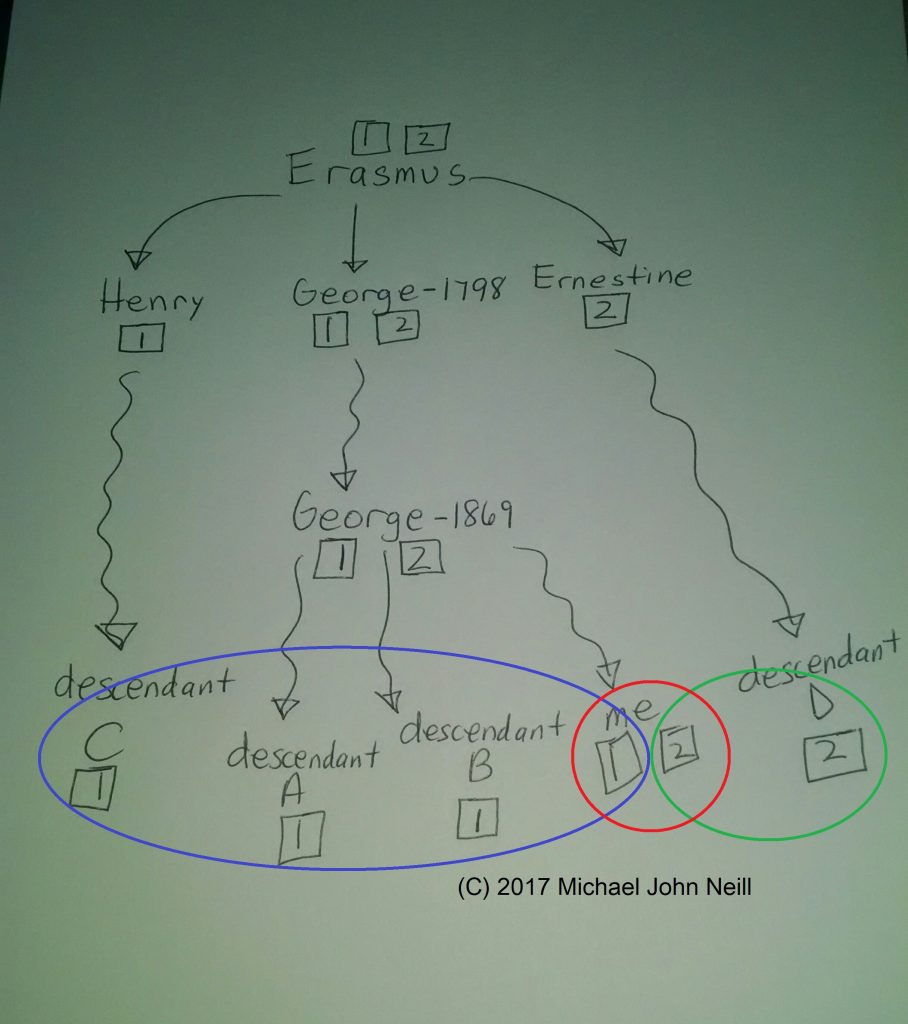
Descendant D is the other 4th great-grandchild of Erasmus. Clicking on the image will explain this chart which also discusses the other three descendants shown on the chart.
[note: this post has been corrected on 22 November 2017]
DNA analysis is often about the numbers.
When I reviewed my DNA matches one of the first surprises I made was another descendant of Erasmus and Anna Catharina (Groß) Trautvetter. These are not a set of recent ancestors. Erasmus and Anna Catharina were married in 1791 Wohlmuthausen, Thuringen, Germany. That’s where he died in 1841 and where she died in 1823. They are my 4th great-grandparents.
They are also the 4th great-grandparents my Trautvetter DNA match on AncestryDNA. We descend from two different children of the couple–I from Johann George born in 1798 in Dorf Allendorf and he from Ernestine born there in 1804. We are 5th cousins.
“Cousin Statistics” on the International Society of Genetic Genealogy Wiki helped me to see how likely this DNA match was. The Wiki contains probabilities for genetic connections based upon a study by Kevin P Donnelly, Statistical Laboratory, Cambridge University, Cambridge, England. (Source: Theoretical Population Biology 1983: 23, 34-63).
- The probability that 5th cousins have no detectable DNA relationship is 69.8%. It would not have been unusual for the two of us to share no DNA relationship.
- There is a .56% chance that I have no DNA relationship to any individual 4th great-grandparent. That’s a good chance. The chance that I have no DNA relationship to a specific ancestor increases as the number of generations increases.
The probabilities do not mean that I’m not related to these distant relatives. It simply means that there’s been so many generational passings of the DNA from parent to child that the DNA shared becomes limited and smaller as the lineage is traced further and further back. It also makes it less likely that I share DNA with distant cousins.
That explains why a colleague and I share no DNA even though we are both descendants of 17th century residents of Virginia. The connection is likely back at least as far as twelve generations from me–a set of my 9th great-grandparents or 10th great-grandparents. Based on that (and assuming my colleague is the same generation removed from the common ancestor–which may not be true), there’s more than a 94.4% chance that we don’t share any DNA. And that’s even if we share a set of ancestors.

4 Responses
I thought that the closest common ancestors of 4th cousins would be 3rd great grandparents. Did l miss something?
No, you didn’t. That relationship is correct and I’ve modified the post with the correct relationship and the correct probability from the Wiki on ISSOG.org. Thanks for catching that and for commenting–I appreciate it.
Michael
You are speaking about autosomal DNA. A males y-dna and any persons MtDNA passes unchanged, except by mutation, over the generations. Because of those random mutations my father’s yDNA is a closer match to a 5th cousin than to that man’s own 1st cousin. This is an observation. I am no expert on genetics.
You are correct. The blog post is referring to autosomal DNA.